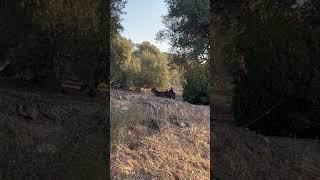The Bengal monitor (Varanus bengalensis) or common Indian monitor, is a monitor lizard found widely distributed over the Indian Subcontinent, as well as parts of Southeast Asia and West Asia. This large lizard is mainly terrestrial, and its length can range from about 61 to 175 cm from the tip of the snout to the end of the tail. Young monitors may be more arboreal, but adults mainly hunt on the ground, preying mainly on arthropods, but also taking small terrestrial vertebrates, ground birds, eggs and fish. Although large monitors have few predators apart from humans who hunt them for meat, younger individuals are hunted by many predators.
The Bengal monitor can reach 175 cm with a snout-to-vent length (SVL) of 75 cm and a tail of 100 cm. Males are generally larger than females. Heavy individuals may weigh nearly 7.2 kg. The populations of monitors in India and Sri Lanka differ in the scalation from those of Myanmar; What was once the nominate subspecies, V. bengalensis, is found west of Myanmar, while V. nebulosus is found to the east. V. nebulosus can be differentiated by the presence of a series of enlarged scales in the supraocular region. The number of ventral scales varies, decreasing from 108 in the west to 75 in the east (Java)
Young monitor lizards are more colourful than adults. Young have a series of dark crossbars on the neck, throat and back. The belly is white, banded with dark crossbars and are spotted with grey or yellow (particularly in the eastern part of the range). On the dorsal surface of young monitors, there are a series of yellow spots with dark transverse bars connecting them. As they mature, the ground colour becomes light brown or grey, and dark spots give them a speckled appearance. Hatchlings of V. nebulosus by comparison tend to have a series of backward-pointing, V-shaped bands on their necks.
Bengal monitors have external nostril openings (nares) that is slit-like and oriented near horizontal, and positions between the eye and the tip of the snout. The nares can be closed at will, especially to keep away debris or water.The scales of the skin are rougher in patches and on the sides, they have minute pits, especially well distributed in males.These scales with micropores have glandular structures in the underlying dermal tissue and produce a secretion which may be a pheromone-like substance. Like other varanids, Bengal monitors have a forked tongue that is protruded in the manner of snakes. The function is mainly sensory, and is not very involved in the transport of food down the throat. Bengal monitors have fat deposits in the tail and body that serve them in conditions when prey are not easily available.
#roaming_owls #learn_about_wildlife #1minutenatureclips #lizard #monitor_lizard #bengal_monitor #big_reptile #udumbu #உடும்பு
For the roaming owls channel :
https://www.youtube.com/channel/UCgNJ...
For more playlists :
https://www.youtube.com/channel/UCgNJ...
For videos of Indian Birds :
https://www.youtube.com/channel/UCm9Y...
For our website :
https://roamingowls.com/
For wildflowers of the world :
https://www.instagram.com/mathiflower...
For our facebook page :
https://www.facebook.com/Roamingowls/
The Bengal monitor can reach 175 cm with a snout-to-vent length (SVL) of 75 cm and a tail of 100 cm. Males are generally larger than females. Heavy individuals may weigh nearly 7.2 kg. The populations of monitors in India and Sri Lanka differ in the scalation from those of Myanmar; What was once the nominate subspecies, V. bengalensis, is found west of Myanmar, while V. nebulosus is found to the east. V. nebulosus can be differentiated by the presence of a series of enlarged scales in the supraocular region. The number of ventral scales varies, decreasing from 108 in the west to 75 in the east (Java)
Young monitor lizards are more colourful than adults. Young have a series of dark crossbars on the neck, throat and back. The belly is white, banded with dark crossbars and are spotted with grey or yellow (particularly in the eastern part of the range). On the dorsal surface of young monitors, there are a series of yellow spots with dark transverse bars connecting them. As they mature, the ground colour becomes light brown or grey, and dark spots give them a speckled appearance. Hatchlings of V. nebulosus by comparison tend to have a series of backward-pointing, V-shaped bands on their necks.
Bengal monitors have external nostril openings (nares) that is slit-like and oriented near horizontal, and positions between the eye and the tip of the snout. The nares can be closed at will, especially to keep away debris or water.The scales of the skin are rougher in patches and on the sides, they have minute pits, especially well distributed in males.These scales with micropores have glandular structures in the underlying dermal tissue and produce a secretion which may be a pheromone-like substance. Like other varanids, Bengal monitors have a forked tongue that is protruded in the manner of snakes. The function is mainly sensory, and is not very involved in the transport of food down the throat. Bengal monitors have fat deposits in the tail and body that serve them in conditions when prey are not easily available.
#roaming_owls #learn_about_wildlife #1minutenatureclips #lizard #monitor_lizard #bengal_monitor #big_reptile #udumbu #உடும்பு
For the roaming owls channel :
https://www.youtube.com/channel/UCgNJ...
For more playlists :
https://www.youtube.com/channel/UCgNJ...
For videos of Indian Birds :
https://www.youtube.com/channel/UCm9Y...
For our website :
https://roamingowls.com/
For wildflowers of the world :
https://www.instagram.com/mathiflower...
For our facebook page :
https://www.facebook.com/Roamingowls/
- Catégories
- Chats de Race Bengal














Commentaires